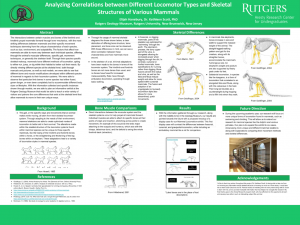Hanebury, Elijah: Analyzing Correlations between Different Locomotor Types and Skeletal Structures of Various Mammals
 Title: Analyzing Correlations between Different Locomotor Types and Skeletal
Title: Analyzing Correlations between Different Locomotor Types and Skeletal
Structures of Various Mammals
Name: Elijah Hanebury
Major: History
School affiliation: School of Arts and Sciences
Programs: Aresty Summer Science Program
Other contributors: Kathleen Scott, Julia Criscione, Patricia Irizarry
Abstract: The interactions between certain muscles and bones of the forelimb and hindlimb propel mammals forward through lever mechanics, with the most striking differences between mammals and their specific movement techniques stemming from the unique characteristics of each species, such as size, environment, and adaptability. The factors that affect how mammals are able to move vary between each individual species, differing through the animal’s muscular differences, specific gait, movement techniques, or generally the skeleton itself. Through their species specific skeletal makeup, mammals have different methods of locomotion, opting to either run, jump, or dig within their habitat to better suit their needs. By directly viewing different species at the skeletal level, both through manuals and pictures, as well as real models, we were able to see that different bone and muscle modifications developed within different species of mammal in regards to their locomotor systems. We were able to observe that particular limb bones in some species had either fused, grown longer, or even been completely lost to accommodate different body sizes or lifestyles. With the information collected and specific instances shown through models, we are able to plan an informative exhibit at the Rutgers Geology Museum that would be able to teach a wide variety of visitors and patrons the core differences that exist at the skeletal level that allow mammals to move in their own unique ways.